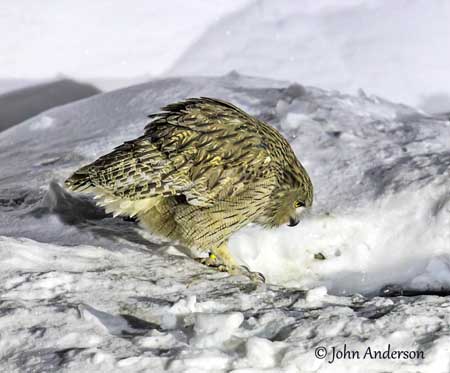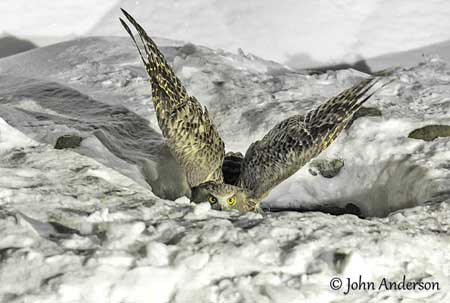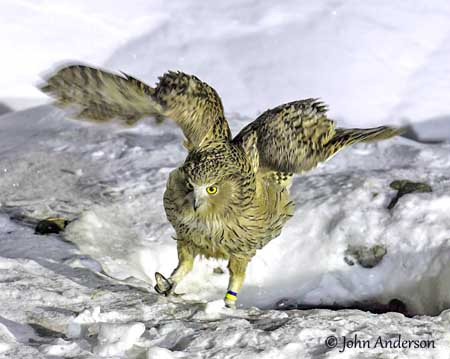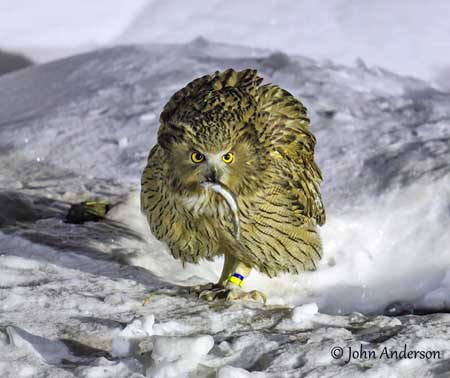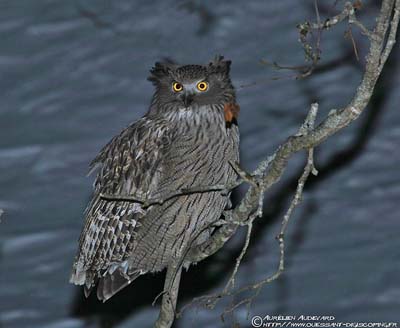
PROTECTION / THREATS / STATUS:
The Blakiston’s Fish-Owl is and ENDANGERED species.
“This large owl has reduced populations (probably less than 2000 birds in the world), and occurs in fragmented range. About 100-150 owls are living on Hokkaido, with 20 breeding pairs.” Aurélien Audevard
The main threats are human developments, deforestation with destruction of taiga forest in Far East and Japan. The owls are forced to move to less productive waters, due to human pressure. This species is vulnerable to hunters and fishermen when they gather around the fishing holes in Siberia.
In addition, the decrease of fish-stocks due to over-fishing involves uncertain future for this superb owl.
Fr: Kétoupa de Blakiston
All : Riesenfischuhu
Esp: Búho Manchú
Ital: Gufo pescatore di Blakiston
Nd: Blakiston-visuil
Russe: Рыбный филин
Sd: Blakistons fiskuv
Photographers:
John Anderson
John Anderson Photo Galleries
Aurélien Audevard
OUESSANT DIGISCOPING
Text by Nicole Bouglouan
Sources:
HANDBOOK OF THE BIRDS OF THE WORLD Vol 5 by Josep del Hoyo-Andrew Elliott-Jordi Sargatal - Lynx Edicions - ISBN: 8487334253
BirdLife International (BirdLife International)
Wikipedia (Wikipedia, The Free Encyclopedia)
Article: Fish-owls
Blakiston’s Fish-Owl
Bubo blakistoni
Strigiforme Order – Strigidae Family
BIOMETRICS:
Length: 60-72 cm
Wingspan: 180-190 cm
Weight: M: 3000-3700 g – F: up to 4500 g
DESCRIPTION:
The Blakiston’s Fish-Owl is an Asian species.
This large owl is considered as ENDANGERED species, due to human’s activities and destruction of the native forest, but also persecution and decrease of fish stocks.
This owl was named after the English naturalist Thomas Blakiston (1832-1891) who found the first specimen on Hokkaido in 1883.

The Blakiston’s Fish-Owl is one of the largest owls.
Adult has buff-brown upperparts with broad dark streaks, except the almost white tail which shows several dark bars.
On the underparts, throat is white. Rest of underparts is pale buffy-brown, finely streaked with long blackish marks.
Legs are feathered, but not the feet which are brown-grey with black claws.
On the head, we can see two long, broad ear-tufts. The facial disc is pale grey-brown. The bill is grey with yellowish tip. Eyes are orange-yellow and lores are whitish.
Both sexes are similar in plumage, but female is larger than male.
The juvenile is spotted, and the upperpart's feathers are edged whitish.
It reaches its sexual maturity at three years.
We find four subspecies:
B.b. piscivorus is paler and occurs in W Manchuria.
B.b. doerriesi is larger and shows white crown patch. This race occurs in SE Siberia and extreme NE China, to the Korean border.
B.b. karafutonis is smaller and darker than nominate, with narrower tail bars. This race is found in Sakhalin Island.
B.b. blakistoni (described and displayed here) occurs in Hokkaido and S Kuril Islands.
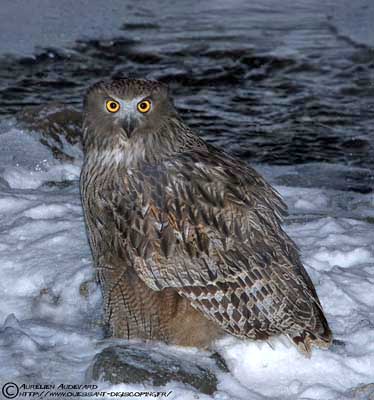
VOICE: SOUNDS BY XENO-CANTO
The Blakiston’s Fish-Owl utters short, deep “boo-bo-voo” or “shoo-oo” as territorial call.
Both mates perform very elaborate duets and these sounds although given by two birds, are similar to the call of only one bird.
The male initiates the duet, giving the 1st and 3d notes, and female produces 2d and 4th notes. The island birds produce 3 notes duets, with male giving the two first, and female the third.
HABITAT:
The Blakiston’s Fish-Owl frequents dense forests with old large trees for nesting. It prefers areas close to lakes, rivers and slow-flowing waters that do not freeze in winter.
In Kuril Islands, it frequents dense conifer forests close to water and even seacoasts.
RANGE:
The Blakiston’s Fish-Owl is found in Siberia, NE China and Hokkaido, Kuril and Sakhalin Islands.
BEHAVIOUR:
The Blakiston’s Fish-Owl feeds primarily on fish, even larger ones. It also catches crustaceans, amphibians and birds such as grouses, and sometimes bats in flight.
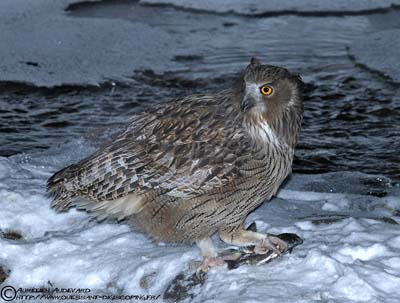
This owl forages at night for fish, and at dusk for amphibians. It may hunt by day too. It usually perches on low branches or other exposed poles, watching for preys in shallow water.
It also walks about on the ground, searching for preys, or sometimes stands in water.
It hunts by jumping on prey, and kills it with the talons. It also catches fish near the surface by swooping down onto the fish, or by diving feet first into deeper water.
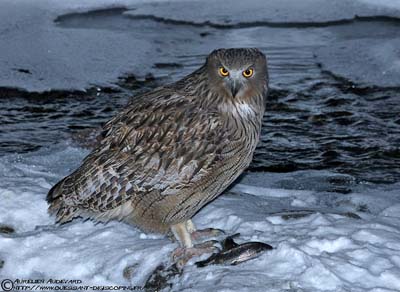
REPRODUCTION:
Laying occurs in late February-mid-March, whereas the snow is still present. The Blakiston’s Fish-Owl nests in large holes in hollow old trees, or in fallen trees or nest-boxes, occasionally on the ground in forest, but rarely.
When it nests in trees, the hole may be up to 18 metres above the ground.
Female lays 2 eggs and incubates during 35-37 days, while the male feeds her on nest. When she leaves the nest for preening, she travels less than 100 metres from the nest-site.
Chicks are covered in white down, and female warms them by day. However, she joins the male for hunting at night.
Young leave the nest between 35 and 45 days after hatching, but they depend on parents for long time, several months or even up to one year, and mainly during the very harsh winters.
DIET:
The Blakiston’s Fish-Owl feeds primarily on fish of all sizes. It also catches crabs, crayfish, frogs, birds up to size of grouses and waterfowl species, occasionally bats in flight and small mammals.
But their diet depends on the food availability.
The largest preys, fish or bird, may be partially eaten on the ground before to be carried on the usual perch or roost.
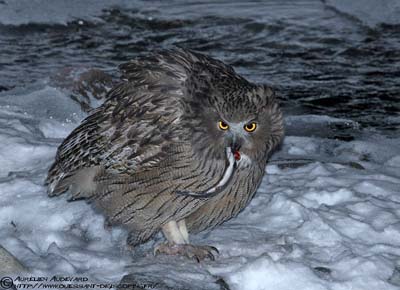
During winter, when the water is frozen, it may be seen waiting quietly close to an air hole in the ice, and small groups of 5-6 birds may hunt together, as evidence of gregarious feeding behaviour.
The Blakiston’s Fish-Owl starts to perform courtship displays in January-February, and courtship-feeding by male occurs four days before the first copulations. They do not breed every year but in alternate year, and pair-bonds are probably for life. This species is highly territorial.
The Blakiston’s Fish-Owl is resident within its restricted range. Immature do not disperse widely, and usually return to the feeding-station in their natal areas.
FLIGHT:
The Blakiston’s Fish-Owl lacks the comb-like fringe on the primary feathers on the leading edge, involving a flight not as quiet and silent as that of other Strigidae species.
